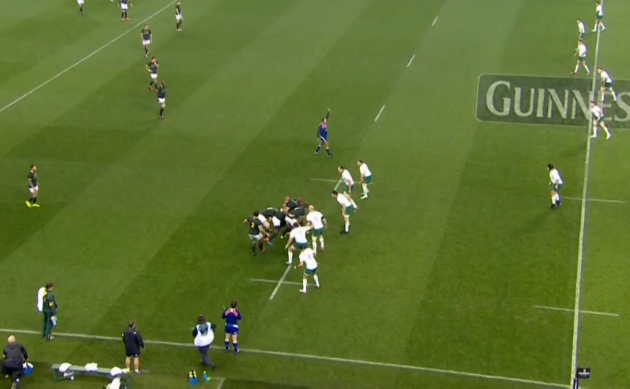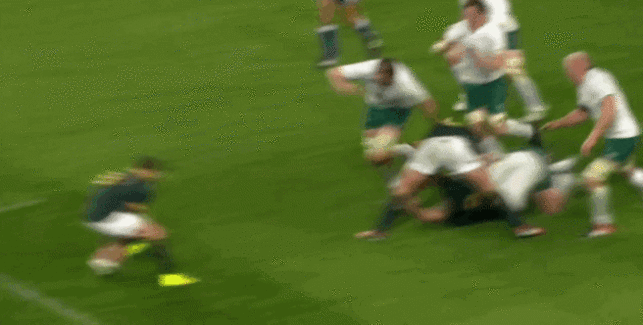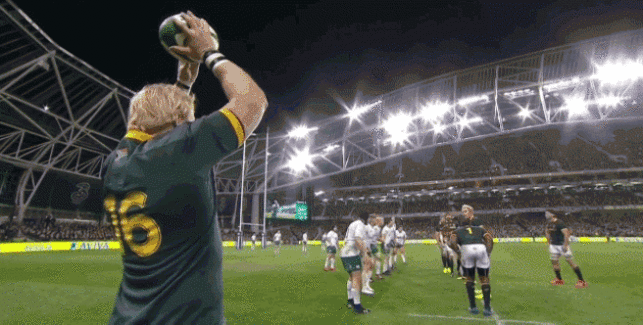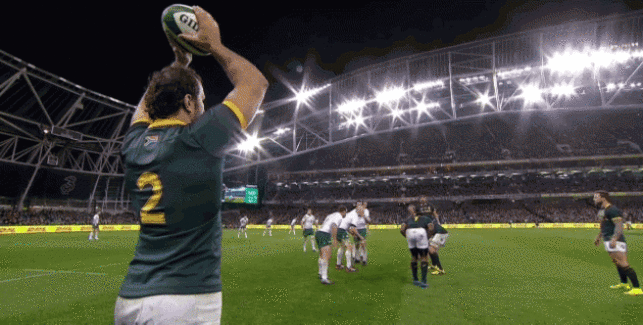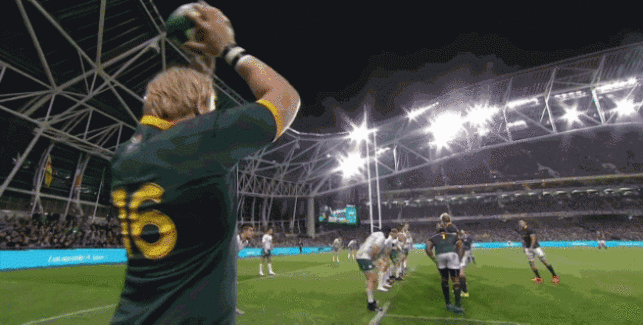COMING INTO SATURDAY’s Test match against South Africa, Ireland were well aware that the Springboks’ line-out maul was going to be a major threat.
As it proved, Heyneke Meyer’s side did score directly from a maul but, that incident aside, Simon Easterby’s pack managed the South African drive extremely well. The manner in which they did so points to the intelligence and preparation of this Ireland group.
Dealing with a strong opposition maul is no easy feat. If the attacking side is well-organised and physically powerful, there can be occasions when halting their drive is nigh on impossible.
Confronted with the Boks’ maul in recent times, New Zealand and Australia have gone down the obvious route of simply driving against it, or looking to sack it before it even gets going. Those are defensive tactics that every team in the world uses against the maul.
Easterby’s touch
Ireland went for something a little more unexpected in their efforts to stop the South Africans from dominating at maul time last weekend.
New forwards coach Simon Easterby has big shoes to fill after taking over from John Plumtree, but on the evidence of his first match in charge, there will be progress. That said, the Irish pack will certainly expect to improve on their display at the scrum and attacking line-outs.
As we have stressed before, Paul O’Connell is a major influence on the work Ireland do in these areas of the game. The 35-year-old has vast experience and is an avid student of the game, meaning his role involves being central to the composition of tactics.
Both Easterby and O’Connell are likely to have played parts in the play we highlight below.
In from the side
The first sign that Ireland were going to do something different with their maul defence came with just 2:35 on the clock and after South Africa’s very first line-out.
We see in the video above that Jack McGrath is sent haring around the side as South Africa set up their maul platform following Bismarck du Plessis’ throw from touch. On first watch, our instinct might be that this is a penalty to the Boks, but referee Romain Poite is superbly aware of what is happening.
As we see in the screenshot below, no Irish player has engaged with the South Africans, instead standing off as the Boks set up what they intend to be a maul. The Irish stand-off means that there is actually no maul, as that would require players from both sides.
In turn, that leaves Jack McGrath free and legal to immediately target the ball at the tail of the Boks’ formation. The loosehead prop has been designated this task to shoot up and around in on the ball, and does so very effectively.
Ireland miss out on a turnover or choke tackle on this occasion, but it lays the foundation for a stronger example later in the half.
The key is that no Irish player has engaged with the Boks, meaning no offside line has been formed yet. The ball is essentially in open play and McGrath is therefore entitled to play it.
It’s worth stressing that standing off the maul is not a new or revolutionary tactic. In fact, it’s something we see more often at lower levels of the game, where sides have less time to invest in maul defence.
Saracens, Glasgow and several other teams have also used the tactic even this season, but there have been examples throughout the game for many years. Where we haven’t seen it has recently been at international level, and Ireland used it very effectively.
We get one of those examples from Sarries below, but there is a crucial point that relates to Ireland in this video.
Paul O’Connell is adamant in this instance that Munster should not have conceded the turnover. Saracens stand off the line-out exactly like Ireland did in out first example, but, crucially, O’Connell hangs onto the ball even after he lands.
Pascal Gaüzère believes the ball has been transferred to the back of the Munster ‘maul,’ explaining why he awards the scrum to Saracens. O’Connell tells him, “I had the ball, I had the ball.”
Ireland’s tactics of sending a ‘shooter’ [McGrath] around the corner against South Africa perfectly took advantage of the fact that the Boks are superb at getting the ball immediately to the tail of their line-out.
In essence, Ireland’s analysis made a South African strength into a weakness at times.
Turnover
The example in the video above comes with around 34 minutes gone and the Boks trailing 6-0. It’s exactly the kind of position in which Meyer’s men like to maul, a mid-distance area of the pitch from which a five-point concession would be a major psychological blow.
Again, Ireland simply stand off as the Boks get into the air, take a clean catch, find superb shape on their maul and send it to the tail with notable speed. It’s not an easy thing for Ireland’s forwards to do, particularly in such a physical game.
With the adrenaline flowing, it would be understandable for someone to smash into the Boks, or attempt to drag Victor Matfield down after his catch of du Plessis’ throw.
Instead, the likes of Peter O’Mahony and Paul O’Connell are disciplined enough to wait, allowing McGrath to burst around to the tail of the South African ‘maul’ and wrestle Marcel Coetzee to deck.
As we see above, Coetzee panics a little against a defensive play he simply isn’t expecting and throws a loose pass back to scrum-half Francois Hougaard. Devin Toner, O’Mahony and O’Connell are rabid in arriving onto the scene and get the chance to unleash their aggression, having been patient just moments ago.
The choke tackle secures a brilliant turnover that comes right from the training pitch at Carton House.
Smarts
In the GIF above, we get a third illustration of the very same tactic from Ireland, with McGrath again coming from the back of the line-out to stop Coetzee well behind the gainline.
All evening, Ireland looked for chances to frustrate the Boks in this manner, foregoing their usual levels of competition in the air in order to do so.
As we saw last season, O’Connell, Toner and O’Mahony are wonderful at spoiling in the air at the defensive line-out. However, the GIFs above and below show that there were times when Ireland simply didn’t even attempt to get off the deck.
There was certainly temptation to take on Matfield an co. in that manner, but Ireland showed intelligence on having the patience not to do that. When it comes to forward play, being the most ‘manly’ pack around is an easy trap to fall into.
By that, we mean Ireland could have simply said ‘We will get in the air every time they do and we will drive their maul into the ground when they look to rumble forward.’ That’s how so many others have approached the task, and among the reasons they have failed.
Instead, Easterby and O’Connell looked for a simpler solution and came up with something intelligent that largely worked.
Work-ons, always
Easterby and his forwards have much to work on over the next two weekends, including their maul defence. They leaked a try in the second half to the South African maul, allowing Meyer’s side a brief sniff of the momentum at a crucial time.
As we can see above, Toner looks to sack Matfield when the Boks’ lock lands, but just takes a crucial extra split-second to do so. By the time the veteran second row goes to ground, his teammates are well set and have sheared away to the right.
Their ability to maintain their feet while hammering forward is impressive, but it’s a score Ireland will have been angry to have given up. Georgia have a large, powerful pack of forwards and while Easterby’s men are unlikely to use the same defensive tactics, it will be intriguing to watch their work at the maul this weekend.

